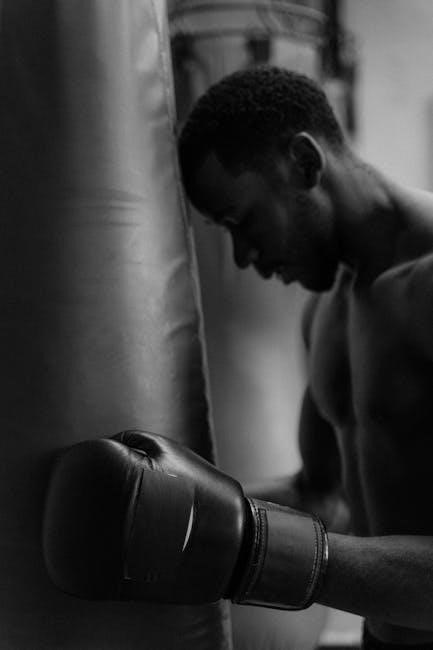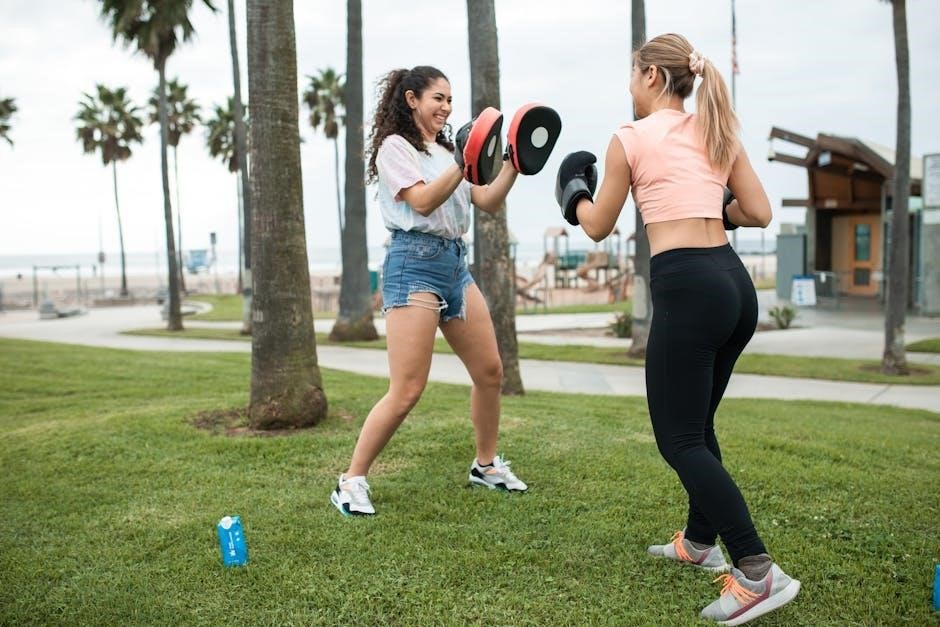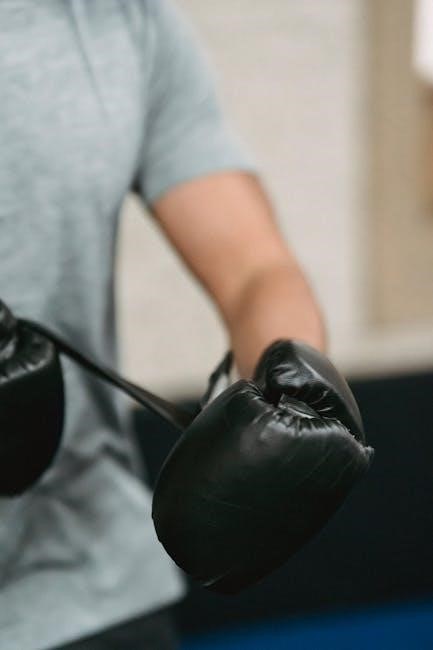Boxing glove sizes are measured in ounces, typically ranging from 6oz to 18oz. The right size depends on weight, hand size, and intended use, ensuring safety and performance.
Importance of Proper Fit in Boxing Gloves
A proper fit in boxing gloves is essential for both safety and performance. Ill-fitting gloves can lead to injuries, poor technique, and discomfort during training or competition. Gloves that are too tight may restrict hand movement, while those that are too loose can cause blisters or inadequate support. A well-fitting glove ensures optimal protection for the hands and wrists, reducing the risk of long-term damage. It also enhances grip and control, allowing for more precise punches and better overall performance. Properly fitted gloves promote comfort during prolonged training sessions, enabling athletes to focus on their technique and endurance without distractions. Ultimately, the right fit is crucial for maximizing safety, comfort, and effectiveness in boxing.
Overview of Boxing Glove Size Guide
Boxing glove sizes are primarily determined by weight, measured in ounces, ranging from 6oz to 18oz. The size guide helps athletes choose gloves based on their weight, hand size, and intended use. Common sizes include 8oz, 10oz, 12oz, 14oz, 16oz, and 18oz, with each weight catering to specific activities like training, sparring, or competition. Proper sizing ensures safety, comfort, and optimal performance. The guide also considers hand circumference and length, providing a comprehensive approach to selecting the right gloves. By following the size chart, boxers can avoid the risks of ill-fitting gloves, such as injury or poor technique. This overview emphasizes the importance of matching glove size to individual needs for peak performance and protection.
Understanding Boxing Glove Sizes
Boxing gloves are sized by weight in ounces, typically ranging from 6oz to 18oz. The size reflects the glove’s weight, padding, and intended use, ensuring proper fit and protection.
Boxing Glove Sizes by Weight (Ounces)
Boxing gloves are sized by their weight in ounces, ranging from 6oz to 18oz. Common sizes include 8oz, 10oz, 12oz, 14oz, 16oz, and 18oz. Lighter gloves (6-8oz) are ideal for smaller individuals or those with less hand mass, while heavier gloves (14-18oz) are suited for larger boxers or sparring sessions. The weight reflects the amount of padding, with heavier gloves offering more cushioning and protection. Proper sizing ensures optimal performance, safety, and comfort. Measuring hand circumference and considering activity type (training, sparring, or competition) helps determine the appropriate weight. Gloves that are too light may lack protection, while overly heavy ones can hinder movement. Choosing the right weight balances protection and dexterity, ensuring a safe and effective training experience.
Boxing Glove Weight Categories and Uses
Boxing gloves are categorized by weight, with each weight serving specific purposes. Lighter gloves (6-8oz) are ideal for competitive boxing, providing minimal padding for a more precise feel. Medium-weight gloves (10-12oz) are versatile, suitable for both training and sparring, offering a balance of protection and mobility. Heavier gloves (14-16oz) are recommended for heavy bag work and intense sparring, as they provide maximum cushioning and shock absorption. The 18oz gloves are typically used by larger or heavier boxers for added protection. The weight category should align with the intended activity, ensuring safety and performance. Proper weight selection prevents injury and enhances training efficiency, making it a critical factor in choosing the right gloves.

How to Measure Your Hand for Boxing Gloves
Measure your hand circumference just below the knuckles using a flexible tape measure. This determines the appropriate glove size for a snug, comfortable fit.
Measuring Hand Circumference
To determine your boxing glove size, measure the circumference of your dominant hand just below the knuckles. Use a flexible tape measure or a string to wrap around your hand snugly but not too tight. Ensure your fingers are slightly spread and your hand is relaxed. This measurement helps identify the appropriate glove size for a comfortable fit. Proper hand circumference measurement is crucial to avoid gloves that are too tight, which can restrict movement, or too loose, which may reduce support. Most size charts correlate hand circumference with glove weight, ensuring the right balance between protection and dexterity. Accurate measurement is essential for optimal performance and safety during training or competition.
Measuring Hand Length and Width
Measuring hand length and width is essential for ensuring a proper fit in boxing gloves. To measure hand length, place a ruler or tape measure from the base of the wrist to the tip of the middle finger. For width, measure across the palm at the widest point, just below the knuckles. These measurements help determine the appropriate glove size, especially for individuals with larger or smaller hands. Combining hand length and width with weight categories ensures a balanced fit, providing adequate support and mobility. Proper measurement prevents gloves from being too tight or too loose, which can affect performance and comfort during training or competition. Accurate hand dimensions are crucial for selecting the right glove size.

Factors Influencing Boxing Glove Size
Weight, hand size, and intended use are key factors in determining boxing glove size. Proper fit ensures comfort, support, and protection during training or competition.
Weight and Body Mass
Weight and body mass significantly influence boxing glove size. Generally, lighter boxers (under 50kg) opt for 6oz gloves, while heavier boxers (over 90kg) prefer 14oz or 16oz. The weight ensures proper padding and protection, balancing comfort and performance. Heavier gloves provide more cushioning for larger hands and higher impact during sparring or competitions. Conversely, lighter gloves allow for better speed and agility, ideal for training or smaller boxers. The size chart aligns glove weight with body mass, ensuring optimal fit and safety. Proper sizing prevents injuries and enhances performance, making weight a critical factor in selecting the right gloves.
Hand Size and Shape
Hand size and shape play a crucial role in determining the right boxing glove size. Measuring hand circumference just below the knuckles helps identify the appropriate fit. Smaller hands typically require gloves with a snugger fit, while larger hands need more room for comfort and dexterity. The shape of the hand, whether broader or narrower, also affects how the glove sits. Proper fit ensures fingers can move freely without feeling cramped, while also preventing excessive movement that could cause blisters. Gloves that match hand size and shape provide better control and protection, enhancing performance during training or competition. Ensuring a glove fits well is essential for both safety and effectiveness in boxing.
Intended Use (Training, Sparring, Competition)
The intended use of boxing gloves significantly influences size selection. Training gloves, typically weighing 12-14 oz, are designed for heavy bag work and pad drills, offering durability and cushioning. Sparring gloves, usually 16 oz, prioritize protection for both the wearer and opponent, with extra padding to reduce impact. Competition gloves, often lighter (8-10 oz), focus on speed and precision, meeting regulatory standards for professional fights. The activity type determines the balance between protection, mobility, and weight distribution. Choosing the right glove for its intended use ensures optimal performance, safety, and compliance with training or competition requirements. Proper sizing for the specific activity enhances overall effectiveness and reduces injury risks.
Boxing Glove Size Chart
Boxing gloves are sized by weight (6-18 oz) and activity type. Charts typically categorize sizes for training, sparring, and competition, ensuring proper fit for performance and safety.
Size Chart by Weight (Ounces)
Boxing gloves are categorized by weight, ranging from 6oz to 18oz. The size chart typically includes:
– 6oz: Suitable for boxers under 50kg, ideal for light training.
– 8oz: Recommended for 51-63kg, commonly used for sparring and competitions.
– 10oz: Designed for 64-74kg, perfect for general training and bag work.
– 12oz: Ideal for 75-90kg, offering a balance between protection and performance.
– 14oz and 16oz: Best for boxers over 90kg, providing extra cushioning and support.
– 18oz: Used for heavy training and larger hands, ensuring maximum comfort and protection.
This size chart helps boxers choose gloves that match their weight and activity, ensuring optimal performance and safety in the ring.
Size Chart by Activity Type
Boxing gloves are tailored to specific activities, ensuring optimal performance and safety. Here’s a size chart based on activity type:
– Training Gloves: 12oz to 16oz, ideal for general training and bag work, offering a balance of protection and cushioning.
– Sparring Gloves: 14oz to 16oz, designed for partner drills and sparring, providing extra padding to protect both hands and faces.
– Competition Gloves: 8oz to 10oz, used in professional matches, lighter for better hand speed and precision.
– Bag Gloves: 6oz to 8oz, lightweight for heavy bag and pad work, focusing on technique and speed.
Choosing the right size based on activity ensures gloves meet the demands of each training or competition scenario, enhancing performance and reducing injury risk.
Size Chart by Hand Measurement
Hand measurement is a key factor in determining the right boxing glove size. Measure the circumference of your dominant hand just below the knuckles. Here’s a general guide:
– Small: Less than 18 cm (6.7–7.5 inches), suitable for youth or smaller hands.

– Medium: 19–20 cm (7.5–7.9 inches), ideal for average-sized hands.

– Large: Over 20 cm (7.9 inches), designed for larger hands or those with broader palms.
This method ensures a snug, comfortable fit, preventing movement that could cause discomfort or injury. Proper hand measurement aligns with glove sizes, enhancing performance and protection during training or competition.
Common Mistakes to Avoid
Choosing gloves that are too tight can restrict movement and cause discomfort, while gloves that are too loose may not provide adequate support or protection.
Choosing Gloves That Are Too Tight
Choosing boxing gloves that are too tight can lead to restricted hand movement, discomfort, and even injury. Tight gloves may cause poor circulation, numbness, and fatigue during training or sparring. They can also hinder proper technique, as fingers and wrists may not move freely. Additionally, tight gloves might not allow for adequate hand wrapping, which is essential for protecting bones and joints. It’s important to ensure a snug but comfortable fit, allowing for a full range of motion. Gloves that are too tight can compromise performance and increase the risk of long-term damage to hands and wrists. Always prioritize a balance between support and flexibility when selecting glove size.
Choosing Gloves That Are Too Loose
Choosing boxing gloves that are too loose can compromise both performance and safety. Loose gloves may cause the hand to shift inside, leading to discomfort, blisters, and inadequate protection. This can result in poor technique, as the gloves may not stay in place during punches, reducing accuracy and power. Additionally, loose gloves can leave the hands and wrists more vulnerable to impact, increasing the risk of injury. Proper fit is essential to ensure optimal support and control. Gloves that are too loose may also fail to provide adequate cushioning, making training or sparring less effective. It’s crucial to select gloves that offer a snug fit while allowing for hand wraps, ensuring both protection and mobility. A well-fitting glove is key to peak performance and safety in boxing.

How to Choose the Right Weight
Boxing glove weight ranges from 6oz to 18oz, with heavier gloves offering more padding for sparring and lighter ones for speed training. Choose based on activity and comfort.
Weight Recommendations for Different Activities
Boxing glove weight varies by activity: 10-12oz for training, 12-14oz for sparring, and 6-8oz for bag work. Competitions typically use 8, 10, or 12oz gloves. Lighter gloves enhance speed, while heavier ones provide more padding for impact absorption. For heavy training or larger hands, 14-16oz gloves are ideal. Personal comfort and hand size also influence the choice. Ensure the weight aligns with your specific needs to optimize performance and safety.

Weight and Personal Comfort
Weight and personal comfort are crucial when selecting boxing gloves. Lighter gloves (6-10oz) are ideal for speed and precision, while heavier ones (14-18oz) offer more padding and cushioning for comfort during intense training. Personal comfort varies; some prefer a snug fit for better control, while others opt for a looser feel to accommodate larger hands or reduce pressure. The weight should align with your activity and hand size to ensure optimal performance and safety. Proper padding and cushioning also play a role in comfort, especially during prolonged sessions. Balancing weight and comfort ensures a better training experience and reduces the risk of discomfort or injury.
Material and Fit Considerations

Material and fit significantly impact boxing glove performance. Leather gloves offer durability, while synthetic options provide affordability. Proper fit ensures comfort, support, and protection during training or competition.
Impact of Glove Material on Fit
The material of boxing gloves significantly affects their fit and performance. Leather gloves are durable and provide a snug fit, while synthetic materials are more affordable but may lack the same snugness. High-quality materials ensure better cushioning and support, reducing the risk of injury. Breathable materials, like mesh panels, enhance comfort during intense workouts. The density of the foam padding also influences the fit, with denser foam offering more protection but potentially feeling stiffer. Proper material selection ensures optimal fit, comfort, and protection, making it crucial to choose gloves that align with your training needs and preferences.
Padding and Cushioning
Padding and cushioning in boxing gloves play a crucial role in shock absorption and hand protection. Thicker padding, typically found in heavier gloves, provides superior cushioning, reducing the impact felt during strikes. High-quality foam or gel padding ensures even distribution of force, preventing injuries. The density of the padding varies by glove weight, with sparring gloves having more cushioning for added protection. Proper padding also enhances fit, ensuring the gloves feel neither too tight nor too loose. Adequate cushioning is essential for comfort during prolonged training sessions and sparring. Choosing gloves with the right amount of padding ensures optimal performance and safety, making it a key factor in selecting the perfect pair for your needs.
Types of Boxing Gloves
Boxing gloves come in various types, including training, sparring, competition, and bag gloves. Each type is designed for specific purposes, with weight ranges from 6oz to 18oz.
Training Gloves
Training gloves are designed for general boxing workouts, including pad work, bag sessions, and light sparring. They typically weigh between 12oz and 16oz, offering a balance of protection and flexibility. These gloves are ideal for building endurance and technique. The size is determined by the user’s weight, hand size, and personal comfort. Proper padding ensures hand protection, while durability is key for long-term use. Choosing the right weight and fit is crucial to avoid injury and enhance performance during training sessions.
Sparring Gloves
Sparring gloves are designed for partner drills and light contact, offering enhanced protection for both hands and opponents. They typically weigh between 14oz and 16oz, with 16oz being the most common for sparring. The size is determined by the user’s weight, hand size, and comfort level. Heavier gloves provide more cushioning but may feel bulky, while lighter ones allow for better movement. Proper fit is essential to prevent injury and ensure optimal performance. Gloves that are too tight can restrict movement, while those too loose may not offer adequate support. Choosing the right weight and fit ensures safety and effectiveness during sparring sessions.
Competition Gloves
Competition gloves are specifically designed for official matches and tournaments, typically weighing between 8oz and 10oz, with 10oz being the most common for professional bouts. These gloves are lighter than training or sparring gloves to allow for faster hand speed and precision. The size is determined by the boxer’s weight class and hand size, ensuring a snug yet comfortable fit. They feature less padding than heavier gloves but are engineered to meet strict safety and regulatory standards. Proper fit is crucial to maintain dexterity and protect the hands during high-intensity competition. Competition gloves are made from high-quality materials to ensure durability and performance, making them a vital piece of equipment for any serious boxer.
Bag Gloves
Bag gloves are lightweight gloves designed specifically for heavy bag and pad work, typically weighing between 6oz and 12oz. They are smaller and more compact than training or sparring gloves, emphasizing hand speed and technique. The size guide for bag gloves often correlates with the user’s weight, with smaller sizes (6-8oz) suitable for lighter individuals (up to 45kg) and larger sizes (10-12oz) for heavier users (46-68kg). Proper fit is essential to prevent injury, ensuring the gloves are snug but not restrictive. Measuring hand circumference and considering personal comfort are key to selecting the right size. Bag gloves are a versatile option for those focusing on striking drills and bag training, offering both protection and dexterity.

Special Considerations
Special considerations include ensuring proper fit with hand wraps and prioritizing long-term durability. Gloves should accommodate wraps without feeling too tight, while high-quality materials ensure extended lifespan.
- Fit with hand wraps is crucial for comfort and protection.
- Durable materials enhance longevity and performance over time.
Fit with Hand Wraps
Proper fit with hand wraps is essential for comfort and protection. Boxing gloves should accommodate hand wraps without feeling too tight or restrictive. When measuring your hand, consider the added bulk of wraps, as they can affect the glove’s fit. A snug but not overly tight fit ensures optimal performance and prevents discomfort during training or competition. Different activities may require varying levels of wrap thickness, so it’s important to test the fit with your preferred wraps. Properly fitting gloves with hand wraps help prevent injuries and enhance your overall boxing experience.
- Hand wraps add bulk, so gloves must fit comfortably with them.
- A snug fit ensures protection and prevents restrictive movement.
- Test glove fit with your preferred hand wraps for accuracy.
Long-Term Durability
Long-term durability of boxing gloves depends on material quality, construction, and maintenance. High-quality leather gloves are more durable than synthetic ones, offering better resistance to wear and tear. Proper padding and cushioning also contribute to longevity by absorbing impact effectively. Regular cleaning and storage in a dry environment help prevent degradation. Reinforced stitching and robust thumb attachments are key indicators of durable gloves. Additionally, avoiding extreme temperatures and moisture ensures the gloves remain in good condition. Durable gloves provide consistent performance over time, making them a worthwhile investment for serious boxers. Proper care and selection of materials can significantly extend the lifespan of your gloves.
- Premium materials like leather ensure longer durability.
- Regular maintenance prevents wear and tear.
- Reinforced stitching and padding enhance longevity.

Conclusion
Selecting the right boxing glove size is crucial for optimal performance, safety, and comfort. Properly fitting gloves prevent injuries, enhance technique, and ensure longevity. By considering weight, hand size, and intended use, boxers can make informed decisions. Material quality and fit also play a significant role in comfort and durability. Always try gloves with hand wraps to ensure the best fit. Investing time in choosing the right size guarantees a better training and fighting experience. Remember, ill-fitting gloves can lead to discomfort or injury, while the right pair elevates your performance. Prioritize your needs and preferences to find the perfect gloves for your boxing journey.
- Proper fit ensures safety and performance.
- Consider weight, hand size, and activity type.
- Material and comfort are key to long-term use.